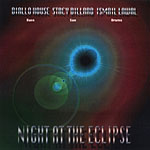Home » Jazz Articles » Live Review » Overtone Quartet on Display at Kennedy Center
Overtone Quartet on Display at Kennedy Center
October 10, 2009
Washington, D.C.
The Overtone Quarter played together as a group for the first time in Washington, DC at the Kennedy Center's Terrace Theater Saturday. The four musicians—Dave Holland, Jason Moran, Chris Potter, and Eric Harland—each took the stage as a master of his art, and the quartet featured musical compositions by each.

Assuming the role of the senior musician, Dave Holland introduced his colleagues at the opening of the show and provided the names of each song as the set progressed. Holland made clear, however, that he is not the group's leader; this group has no band-leader, and instead functions as a collective, coming together around the shared goals of challenging each other to greater and more subtle composition and performance.
The audience was treated to a series of dramatically different songs, each a platform for the individual musicians to display their unique voices, as well as the band's ability to execute a wide spectrum of musical territory.
The group began with "Treachery," an up-tempo composition by Harland built on a pulsating beat. Moran took the first solo, riding atop the wave-like groove, alternately skipping across the crests and plunging into the troughs to create a rhythmically spirited effect. Taking a different tack altogether, Potter seemed to cut directly across the groove with a rising torrent of notes that drove the band to an energetic crescendo.
The band turned next to Potter's aptly titled "Minotaur," a funky maze of rhythmic twists forming a hybrid tune that though never seeming to settle on a completed form, clearly provided a welcome challenge to Harland, Potter, and Moran (now on organ) as they navigated their way through its complex turns and varied textures.
The third tune "Blue Blocks" exhibited both Moran's insightful composing and his nuanced soloing capabilities. From the solo piano intro to the powerful exchanges with Potter, to a tender solo by Holland, this slow blues proved one of the evening's highlights. Moran took advantage of the tune's catchy, tripling rhythm to display his signature ability to blend classical, blues, pop, and jazz forms, folding the various components of his solos like an origami master to form unexpected contradictions and intellectually challenging shapes of surprising emotive clarity.
Following another Potter composition, the jaunty "Outsiders," the group turned to the second peak of the set, Holland's "Veil of Tears." Centered on Holland's middle-eastern themed bass lines, "Veil of Tears" was the most unusual composition of the evening, and the one on which the band most completely coalesced to deliver an integrated sound built on but subsuming their individualism. On electric organ, Moran encased the whole in a constantly shifting curtain of atmospherics, while Potter, alternating between tenor and soprano sax, delivered one startling solo after another, seeming to transform the distinct sound of his horn into that of traditional Arabic woodwinds or the cry of the muezzin. The band received the night's most effusive audience response for this evocative piece of unusual character.
Inverting moods completely, the band closed out the set with a second, older Holland composition, the up-tempo "Interception." An exuberant freestyle designed to give each player a run for their money, the tune quickly turned into a serious burner as each soloist drove the next to ever more dexterous and rapid-fire heights. Potter particularly shined with a series of breakneck runs delivered in his inimitable style, as did Harland for a closing solo equally impressive for its unusual tonal diversity, dynamic range, and extended intricate structure.
Performed in sequence, with no patter or chit-chat between tunes, the evening's display had the feel of entering a fine arts gallery to view the works of established master craftsmen where the show is not tied to any single theme, personality, stylistic continuity, or artistic vision. Instead, the element binding together the six pieces was their consummate execution and the audience's enjoyment of witnessing four contemporary artists at the peak of their abilities.
The Overtone Quartet is a new force on the scene, designed as an artistic playground for its members where they can push and pull each other in new directions. The results are eminently satisfying and it certainly will be intriguing to see what the Quartet provides its audiences next.
Tags
PREVIOUS / NEXT
Support All About Jazz
 All About Jazz has been a pillar of jazz since 1995, championing it as an art form and, more importantly, supporting the musicians who make it. Our enduring commitment has made "AAJ" one of the most culturally important websites of its kind, read by hundreds of thousands of fans, musicians and industry figures every month.
All About Jazz has been a pillar of jazz since 1995, championing it as an art form and, more importantly, supporting the musicians who make it. Our enduring commitment has made "AAJ" one of the most culturally important websites of its kind, read by hundreds of thousands of fans, musicians and industry figures every month.

























